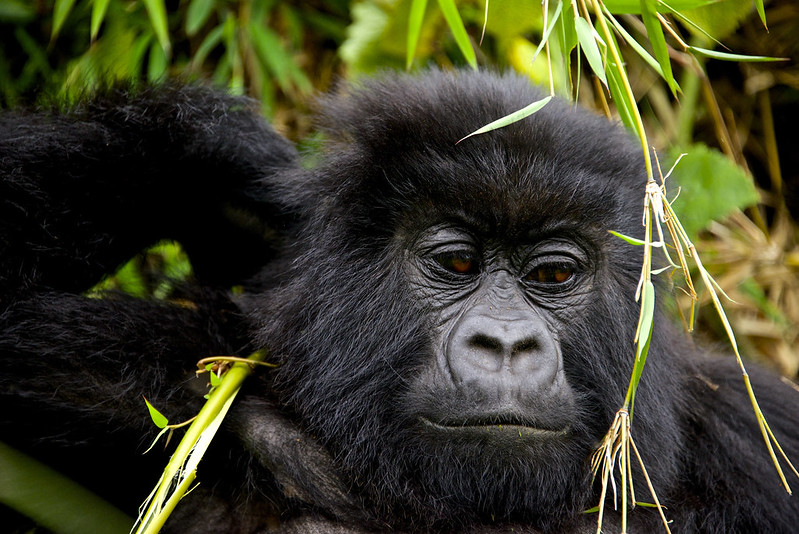Eco Tourism Saving Mountain Gorilla In Africa
Looking back over the past forty years since gorilla conservation efforts began, it is clear that efforts to rescue mountain gorillas in Africa have faced difficult challenges. Mountain gorillas in Africa can now be found in the Virunga volcano region of Eastern Africa thanks to the introduction of gorilla tours. Historically, this area was known for its series of incursions by rebel militias that created a very unsecure atmosphere for the local population as well as park rangers, who at least knew safe places to walk without worrying about stepping on traps and avoiding land mines. The gorillas, who are undoubtedly wild animals that roam the bush freely in search of leaves and bamboo to eat, occasionally stumble into rebels’ traps.
By the 1970s, a number of causes were endangering the mountain gorilla population and posing a serious threat to their survival. In addition to anxieties, a lot of other issues have to be resolved in order to save the gorilla population. Poaching, disease, illegal activity, encroachment of forest habitats that forces gorillas to move around constantly Monkey Trade
In order to prevent gorillas from extinction and mistreatment, American primatologist Dian Fossey founded a study facility. She was a pioneer in protecting mountain gorillas in Africa. Between the Karisoke and Visoke mountains in Rwanda, she set up a gorilla research facility there.
Dian Fossey first battled poachers who were in a high rise in order to safeguard gorillas. Later, poachers killed Dian Fossey, who was buried at her Karisoke centre, but her advocacy for the preservation of endangered mountain gorillas captured the attention of the world and alerted concerned governments to the critical need for ethical ecotourism in order to protect mountain gorillas in Africa.
All issues that were hindering mountain gorilla conservation have already been resolved thanks to significant investment. In central and east Africa, there are now over 1000 gorillas left after just 250 were recorded there previously.
Gorilla tourism was envisioned by Dain Fossey as the only means of saving gorillas. It would be simple to handle the funding of conservation programmes using the foreign exchange received from gorilla safaris. It should be mentioned that the countries where gorillas live rely heavily on the revenue from gorilla tours. For instance, from 2006 to 2013, over a million tourists visited the mountain gorillas in Uganda, Rwanda, and the Democratic Republic of the Congo, contributing to $75 million (£44 million) and over 90% of the nations’ total yearly foreign income.
The Rwandan government established an annual profit-sharing programme in 2005, wherein 5% of the revenue generated by gorilla tourism is invested in the underprivileged local communities that surround the national parks to support local project development initiatives aimed at raising their living standards through the building of roads, water and sewage systems, health facilities and low-cost medical care. It should be highlighted that the neighborhoods near national parks are heavily populated, have high rates of poverty, and have subpar sanitation. Such profit-sharing programs encourage community involvement in gorilla conservation because it benefits everyone.
introduction of stringent guidelines that all visitors to gorilla habitats in Rwanda, Uganda, and the Democratic Republic of the Congo must follow. These regulations were put in place to save the critically endangered mountain gorilla species from dangers including human diseases like tuberculosis, diarrhoea, and influenza that can be fatal to gorillas due to their weak immunity to human illnesses.
When ill, avoid going on a gorilla expedition. If a visitor becomes ill, they should go to the park administration to get their gorilla permit refunded or rescheduled. If you need to sneeze, blow your nose, or cough while you are with the gorillas, move away from the animals. They are extremely vulnerable to human illnesses.
Visitors and gorillas must keep a specified distance of 5-7 metres apart. This is done to safeguard both tourists and gorillas. To prevent the gorillas from becoming overstimulated, only a group of 8 visitors are permitted to spend just one hour with each gorilla family. No eating or drinking while gorillas are present, and most importantly, do not leave trash in the gorilla habitat.
The boundaries of every national park have been clearly marked, preventing locals from trespassing on it. Protecting gorillas is now a shared community obligation in areas where gorilla habitat is not being violated thanks to the introduction of profit sharing from mountain gorilla tourism.
In the end, one is inclined to believe that the past of gorilla tourism has learned something from the time of Dian Fossey and hasn’t forgotten anything given the current forward-thinking rise in gorilla population numbers with reference the most recent continuing gorilla census in the Virunga region and Bwindi Forest national park.


Leave a Reply